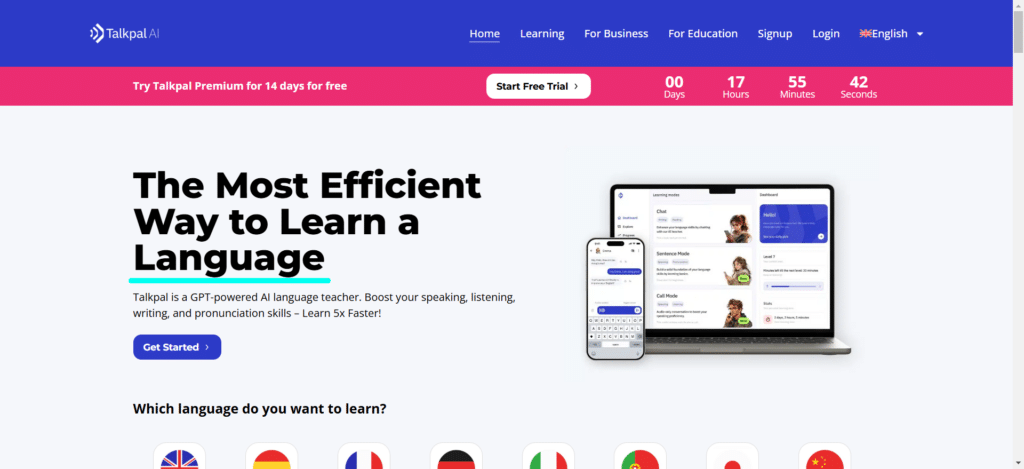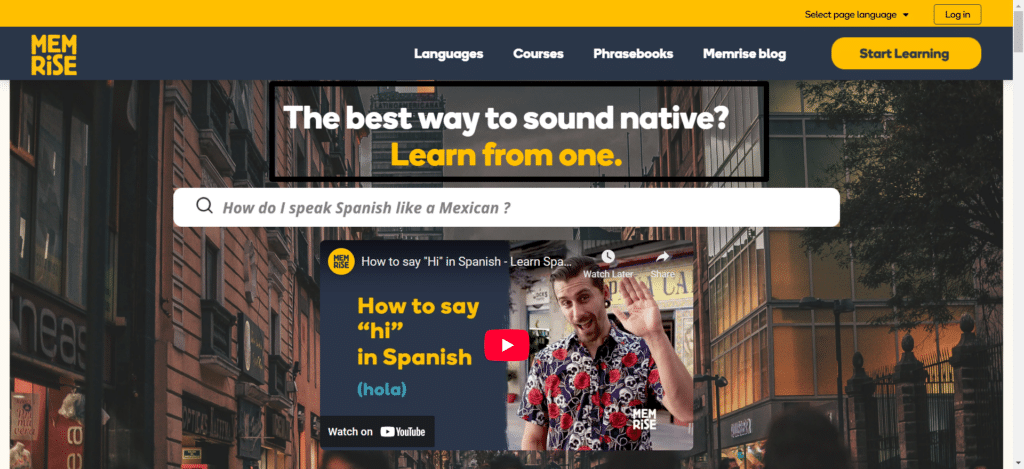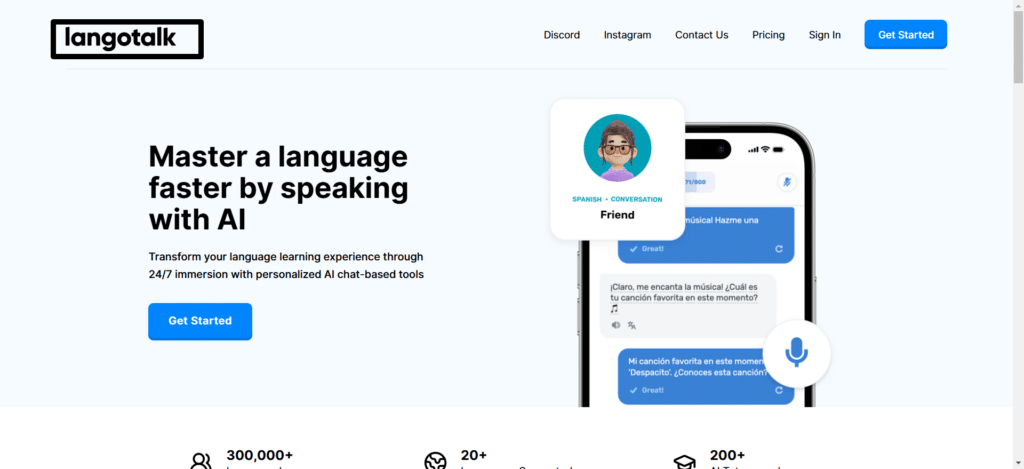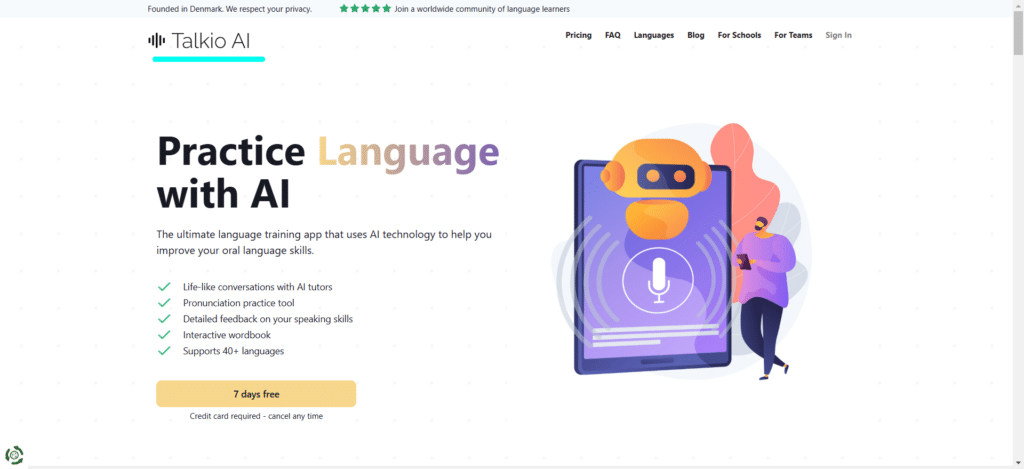
Ever wondered why some people seem to pick up new languages effortlessly?
A recent study by MIT researchers revealed that AI-powered language learning can accelerate fluency acquisition by up to 47% compared to traditional methods!
I’ve spent months testing dozens of language-learning apps, and I’m amazed at how artificial intelligence and machine-learning language software have transformed the way we learn languages.
From real-time pronunciation feedback to personalized lesson plans that adapt to your learning style through adaptive learning platform, these apps are like having a patient, all-knowing language tutor in your pocket.
Ready to discover which AI language learning apps actually deliver results? Let’s dive into the most innovative and effective options available today!
What are the Best AI language learning apps?
Here are my top picks for the best AI language learning apps in 2025
1. Talkpal

I stumbled across Talk Pal a few months ago when I was desperately looking to improve my Spanish speaking skills.
You know how textbooks and flashcards can only take you so far, right? What initially caught my eye was how it uses AI to create these incredibly natural conversations – way different from those robotic language exchanges I’d tried before.
Talk Pal is basically your personal AI language tutor that lives in your phone. The core idea is simple: you have real conversations with an AI that adapts to your level sophisticated language pattern recognition and helps you learn any of the 30+ languages they currently support.
It uses advanced speech recognition and natural language processing to understand user input and provide meaningful feedback contextual language learning
Key Benefits:
- Realistic AI conversations that adapt to your speaking level and pace
- pronunciation feedback with specific tips for improvement
- Personalized learning paths based on your goals (business, travel, or casual chat)
- Progress tracking dashboard that shows your improvement over time
Pros:
- Available 24/7 for practice whenever inspiration strikes
- Never gets tired of repeating phrases or explaining concepts
- More affordable than private tutoring with unlimited conversation practice
- Creates a judgment-free environment to build confidence
Cons:
- Needs a good internet connection for optimal conversation flow
- May take a moment to understand speech in very noisy environments
- Still developing its understanding of some regional expressions and slang
Personal experience using Talkpal
I remember when I first tried Talk Pal, I wasn’t sure if practising with AI would really work.
But after my first session, where I managed to have a basic conversation about my hobbies in Spanish without feeling embarrassed about my mistakes, I was hooked.
The app gave me specific feedback about my pronunciation of ‘r’ sounds and suggested exercises to improve.
For anyone serious about improving their language skills, Talk Pal is a fantastic tool to have in your learning arsenal.The best part? You can practice as much as you want without worrying about booking appointments or coordinating time zones with tutors.
Whether you’re an early bird who likes to practice at dawn or a night owl who gets motivated at midnight, your AI language partner is always ready to help.
2. Memrise

As someone who’s spent countless hours with different language apps, Memrise stands out for its unique blend of AI-powered features and human-curated content. It has an AI-powered chatbot called MemBot that helps users learn new languages efficiently.
What really grabbed me was how it uses AI to create a learning system that feels more like playing a game than studying. The app cleverly combines user-generated content with AI technology to help you remember words and phrases more effectively using vocabulary retention tools that measure language learning effectiveness.
Key Benefits:
- AI-powered spaced repetition system for optimized learning
- Video clips of native speakers with AI pronunciation analysis
- Real-world video content with AI-enhanced translations
- Smart review system that predicts when you’ll forget words
Pros:
- Makes learning feel natural with real native speaker videos
- AI technology remembers your weak spots and focuses on them
- Combines community content with scientific learning methods
- Excellent for building practical, everyday vocabulary
- Engaging gamification that keeps you motivated.
Cons:
- Premium version needed for full AI-powered features
- Some languages have more content than others
- Best results require regular practice sessions
Personal experience using Memrise:
One of my favorite features is how the AI integrates real-world video content into lessons. You’re not just learning textbook phrases – you’re learning language as it’s actually used by native speakers in everyday situations.
The AI helps break down these authentic conversations, making them digestible for learners at any level.
I’ve found Memrise particularly effective for building practical vocabulary. Through its AI-powered system, I learned phrases that I actually use in real conversations, not just the formal language you might find in textbooks.
The app seems to understand which words are most useful for everyday communication and prioritizes them in your learning path.
3. Lango Talk

You know that feeling when you finally find an app that just clicks with how you learn? That’s exactly what happened when I discovered LangoTalk.
What really blew me away was how natural the conversations felt. It’s not just another AI chatbot spitting out pre-programmed responses – it actually understands context and remembers our previous chats.
The app uses some pretty sophisticated AI technology to create these dynamic conversations that deliver truly interactive language practice.
If you’re stumbling with a particular grammar point or pronunciation, it’ll slow down and give you more practice in that area. But once you’ve got something down, it moves on to keep things challenging and interesting.
Key Benefits:
- AI-powered conversation practice with natural dialogue flow
- Real-time pronunciation feedback and correction
- Role-play scenarios for practical language use
Pros:
- engages in natural back-and-forth conversations
- Adjusts language difficulty based on your responses
- Creates customized review sessions
- Available 24/7 for practice
Cons:
- Newer app with growing language selection
- Requires stable internet for best performance
- May take time to adjust to your speaking style
Personal experience with Lango talk:
I remember practicing a restaurant scenario in LangoTalk where the AI actually remembered my food preferences from a previous session – that kind of continuity makes the learning experience feel more personal and engaging.
Those little touches make it feel like you’re chatting with a thoughtful language partner rather than a computer program.
4. Talkio AI

Let me break down what Talkio AI is all about. Think of it as your personal AI language tutor that lives in your phone, but way more sophisticated than your typical language learning app.
At its core, it’s a conversational AI platform designed specifically for language learners who want to move beyond basic phrases and into real, flowing conversations.
The app uses advanced natural language processing and machine learning to create interactive conversations that actually make sense.
It can handle everything from basic “How are you?” exchanges to complex discussions about current events or your favorite Netflix shows.
The AI is constantly analyzing your speech patterns, grammar usage, and pronunciation to provide targeted help where you need it most.
Key Benefits:
- Advanced AI conversation engine with contextual understanding
- Voice recognition with detailed pronunciation scoring
- Customizable conversation topics and scenarios
- Cultural context integration in dialogues
Pros:
- Creates highly engaging dialogue scenarios
- Remembers past conversations for continuity
- Offers culturally relevant speaking practice
- Adapts difficulty in real-time
Cons:
- Monthly subscription required for full features
- languages still in development
- Occasional AI response delays
Personal experience with Talkio AI
With Talkio AI, I was particularly impressed by how it handled complex conversations. When I stumbled over a difficult phrase, it didn’t just correct me – it provided examples of how that phrase is used in different contexts, helping me understand not just the what, but the why of language usage.
5. Mondly

After exploring several language learning apps, I found Mondly’s AI features to be quite intriguing.
While the app offers traditional learning methods, what really caught my attention was its innovative AI-powered conversation practice and virtual reality experiences. These features take language learning beyond basic flashcards and into the realm of immersive practice.
The AR feature deserves special mention too. Being able to point your phone at objects and see their names in your target language, complete with pronunciation guidance from the AI, makes vocabulary learning feel more natural and intuitive.
It’s like having a knowledgeable friend walking around with you, helping you learn the names of everything you see.
Key Benefits:
- AI chatbot conversations with speech recognition
- Virtual Reality lessons for immersive learning (requires VR headset)
- Augmented Reality experience for visualizing objects while learning
- Daily AI-powered conversation scenarios
Pros:
- Combines AI technology with structured lessons for comprehensive learning
- VR/AR features make vocabulary learning more engaging and memorable
- Offers practice with real-world conversation scenarios
- Available in 41 languages with native speaker recordings
Cons:
- Some advanced AI features may require additional hardware
- Free version has limited access to AI conversation practice
- VR content library still growing and being expanded
Personal experience with Mondly
I remember practicing ordering food in Italian, and the AI actually corrected my pronunciation of “vorrei” (I would like) until I got it just right. The immediate feedback made a huge difference in my confidence.
The VR feature was particularly eye-opening. Putting on the headset, I found myself in virtual environments where I could practice the language in context – like a virtual café in Paris or a train station in Berlin. It’s one thing to memorize phrases from a textbook, but it’s entirely different when you’re virtually “there” and need to use the language to navigate.
What is the Future of AI language learning?
The future of AI language learning is shaping up to be incredibly exciting. We’re seeing emerging technologies like multimodal AI that can read facial expressions and provide hyper-accurate pronunciation feedback.
What’s really promising is how future developments will bring us AI tutors with consistent personalities, personalized learning paths that adapt to your energy levels, and seamless integration with AR/VR for immersive practice.
These systems will work hand-in-hand with streaming services, smart home devices, and social learning platforms, making language learning more natural and effective. It’s like having a patient, understanding tutor available 24/7, adapting perfectly to how you learn best.
Conclusion:
The future of language learning is here, and it’s powered by artificial intelligence! These innovative apps combine cutting-edge technology with proven learning methods to create highly effective and engaging experiences.
Whether you’re looking to master basic conversations or achieve professional fluency, there’s an AI-powered solution that fits your needs and learning style.
Lets Take the first step toward your language goals today by choosing the app that best matches your learning preferences and objectives. Don’t forget to regularly practice and take advantage of the AI-powered features these apps offer to maximize your learning potential!
FAQs
How effective are AI language learning apps compared to traditional methods?
AI language apps excel at providing consistent, on-demand practice and personalized feedback that traditional methods often can’t match.
When examining success rate statistics, modern AI apps can significantly accelerate learning through their adaptive technology and unlimited practice opportunities, though they work best when combined with other learning methods.
Can AI apps really help with pronunciation?
Yes, today’s AI apps use advanced speech recognition technology that can detect subtle pronunciation errors and provide specific feedback on how to improve. Many apps even break down sounds and provide visual guides for tongue and mouth positioning.
Are AI language learning apps worth the investment?
When you compare the cost of AI apps to private tutoring or language classes, they offer exceptional value for daily practice and improvement. The subscription fees are typically reasonable for the amount of practice time and personalized feedback you receive.
How long does it take to learn a language using AI apps?
With consistent daily practice of 15-30 minutes, most users see a noticeable improvement in basic conversation skills within 2-3 months. However, reaching fluency varies greatly depending on your target language, starting level, and learning consistency.
